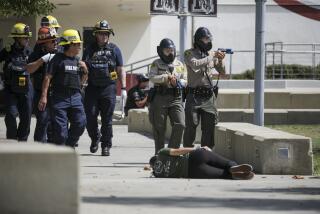The next frontier for school safety: The cafeteria

School cafeterias tend to be crowded and noisy, which can make them dangerous in emergencies.
About 100 school administrators across Los Angeles County gathered to learn about school safety on Monday. About the same time, authorities said a 14-year-old in Ohio opened fire on his cafeteria.
The location is telling.
School shootings are on the rise. There were 38 school shootings in 2013 compared with 64 last year. And the cafeteria is now considered one of the most dangerous places for a school shooting. They’re noisy, crowded spaces that can be hard for kids to escape, and for teachers to control, said Dennis Lewis, the founder of Edu-Safe, a school safety consulting company.
“Cafeteria’s the worst-case scenario,” Lewis said in an interview after Monday’s training in Downey, where he and co-consultant Judy Brunner taught the group how to prevent and react to bomb threats and active-shooter scenarios. Lewis previously directed school safety in Missouri.
After Columbine, the 1999 massacre in which a pair of students killed 13 people and injured dozens more at Columbine High School in Colorado, schools began to take the threat of an assailant more seriously. Schools across the country now have intruder and lockdown plans in place, and some conduct active-shooter drills to prepare students and teachers.
Teachers and administrators around L.A. know to close classroom doors and keep children inside, with the blinds closed and lights off, when necessary.
But what if students are outside the classroom when a shooter pulls a gun?
Los Angeles Unified School District’s lockdown policy, for example, calls for students who are outside to be moved to the nearest room that can be locked, and for students in a cafeteria to be kept there. It doesn’t mention what to do if a shooter is inside the cafeteria along with students.
Lewis didn’t know about the Ohio shooting while the Downey training was in session, but he and Brunner spoke during an interview afterward about how schools can better prepare and react to a threat when students aren’t in the classroom:
1. Prepare ahead of time
The day an assailant appears on campus shouldn’t be the first time a school implements its active-shooter plan, and both teachers and students should know what to do.
Lewis and Brunner suggest teaching the active-shooter and lockdown plan as part of the curriculum at the beginning of the year, with age-appropriate language.
“For the younger kids, you’re talking about running from danger,” Lewis said.
If students are outside, schools can establish safe sites where children and teachers can meet; depending on the scenario, that could be the edge of campus or a nearby park. Schools should tell teachers that if they’re outside and unable to get into a locked classroom, they should run with the students to one of those sites. It’s a good idea to walk the routes with students early in the year, Lewis said.
2. One-word commands
Even if these “reunification sites” are set up, it can be difficult to get students’ attention in playgrounds or outdoor areas. Teachers should tell their students to recognize one word to react to when they hear it. For example, a teacher should just have to scream, “Run!” on a playground to get students’ attention and lead the way to the nearest safe site.
If a shooting occurs on a school bus, for example, the bus driver should be trained to yell, “Down!” and the students should know that means to hide under their seats because there’s a dangerous situation, Lewis said.
3. Give teachers and students options
Students near an exit when an active shooter enters the cafeteria should try to use it. If they can’t do that, they should try to find a place to hide. In a cafeteria, that could include a crawl space under a stage, a storage room for tables or behind a wall or partition, if possible. Both Lewis and Brunner said they couldn’t comment directly on the Ohio shooting.
There are too many variables to create a standard procedure for cafeteria shootings, said Timothy J. Anderson, a deputy chief with the Los Angeles School Police Department. Instead, school police try to train administrators and staff to “think clearly as humanly possible and to be able to make sound decisions,” he said. He echoed Lewis’ advice: Staff and students can escape the room if possible and find cover if it’s not possible to get out.
Lewis said schools should give students directions for survival at the beginning of the year when training them, so that they feel prepared.
The same goes for teachers and administrators: Depending on the situation, an adult close to the shooter might try to take the assailant down when he or she pauses to reload, or might try to get as many students outside as possible if farther away.
There are countless scenarios involving shooters, and are almost impossible to prevent; still, it’s statistically unlikely that any one school will face a shooter on campus, Lewis said.
He admits that not all schools should adopt his plan; parents might object to talking about shootings or school danger with young children. And even with a plan in place, it would be difficult to keep track of children who are running to a designated meeting spot off campus and for them to remember those meeting spots during an emergency situation.
But local schools are thinking about these possibilities more as the threats feel closer to their districts, L.A. County Supt. Arturo Delgado said. School administrators requested the training after the December shooting in San Bernardino, which prompted a districtwide school lockdown, and after L.A. Unified’s recent decision to close its schools following a potential bomb threat.
Reach Sonali Kohli on Twitter @Sonali_Kohli or by email at [email protected].
More to Read
Sign up for Essential California
The most important California stories and recommendations in your inbox every morning.
You may occasionally receive promotional content from the Los Angeles Times.











